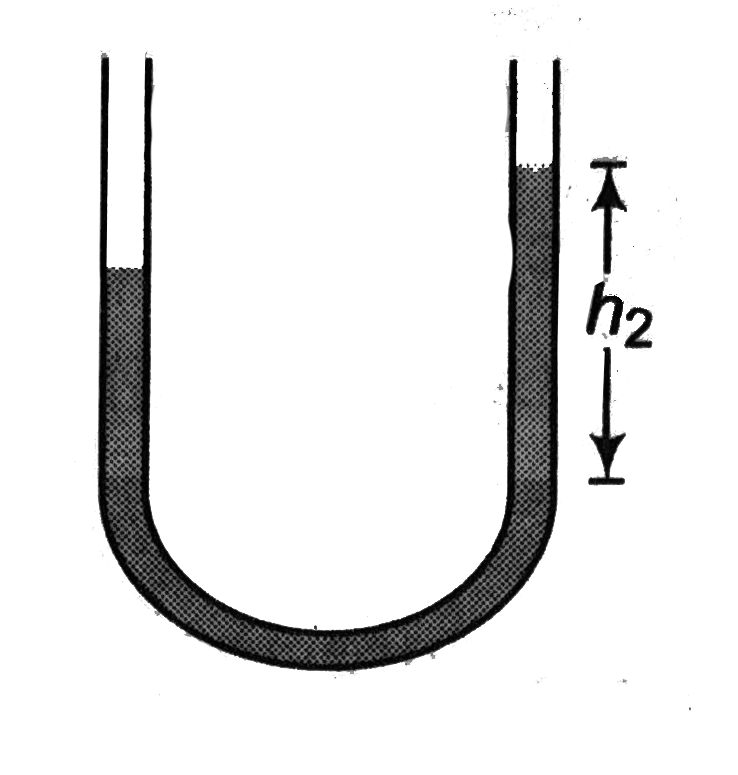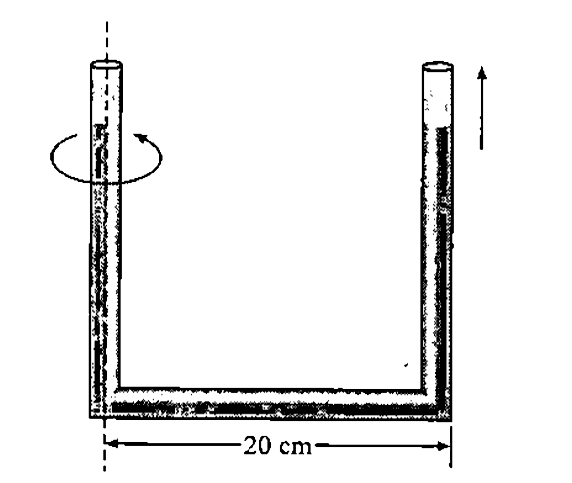The cross-sections of the two sides of a U-tube are 1cm2and0.1cm2 respectively. Some water is poured inside the tube when it rise to the same height in both the limbs. What volume of a liquid of density 0.85g⋅cm−3 should be poured into the wider limb so that the water level rises by 15 cm in the narrow limb?
At first, water rises up to the same level in both the arms. When the liquid is poured into the wider limb, suppose the level of water falls by x cm and rises by 15 cm in the narrow limb.
AC = BF = x ,
volume of the part AC = volume of the part BD
or, x×1=15×0.1or,x=1.5cm

Let EC = h.
Pressure at the point C = pressure at the point F
or, h×0.85×g=(15+1.5)×1×g
or, h=16.50.85=19.41cm
So, the volume of liquid poured into the wider limb = 19.41×1=19.41cm3.
Topper's Solved these Questions
- HYDROSTATICSBOOK - CHHAYA PUBLICATIONCHAPTER - HYDROSTATICSEXERCISE - SECTION RELATED QUESTIONS
12 Videos
- HYDROSTATICSBOOK - CHHAYA PUBLICATIONCHAPTER - HYDROSTATICSEXERCISE - HIGHER ORDER THINKING SKILL (HOTS) QUESTIONS
37 Videos
- FRICTION BOOK - CHHAYA PUBLICATIONCHAPTER - FRICTION EXERCISE - CBSE SCANNER
7 Videos
- KINETIC THEORY OF GASESBOOK - CHHAYA PUBLICATIONCHAPTER - KINETIC THEORY OF GASESEXERCISE - CBSE Scanner
9 Videos
Similar Questions
Water and oil are poured into the two limbs of a U-tube containing mercury. The interface of the mercury and the liquids are at the same height in both limbs.
Determine the height of the water columnh1 if that of the oil h2=20cm. The density of the oil is 0.9.
 .
.
View SolutionWater and oil are poured into the two limbs of a U-tube containig mercury. The interface of the mercury and the liquids are at the same height in both limbs.
Determine the height of the water columnh1 if that of the oil h2=20cm. The density of the oil is 0.9.
 .
.
View Solution
Knowledge Check
A U-tube having horizontal arm of length 20 cm, has uniform cross-sectional area=1cm2, It is filled with water of volume 60 cc. What volume of a liquid of density 4g/ should be poured from one side into the U-tube so that no water is left in the horizontal arm of the tube?
A60ccB45ccC50ccD35ccIn a U-tube diamter of two limbs are 0.5 cm and 1 cm respectively and tube has filled with water (T=72dyne/cm) then liquid level difference between two limbs will be
A0.5 cmB0.25 cmC0.293 cmDnone of theseA U-tube is partially filled with water. Oil which does not mix with water is next poured into one side, until water rises by 25 cm on the other side. If the density of oil 0.8g/cm3. The oil level will stand higher than the water by
A6.25cmB12.50cmC31.75cmD25cm
The cross-sectional area of the U-tube shown in the figure is everywhere uniform and of value 1.25×10−3m2. The horizontal section of the tube is of length 20 cm. When at rest, the limbs of the tube contain a liquid of density 2.5 up to equal heights. If the tube is rotated with angular velocity of 8.4rad/s about one limb, calculate the volume of liquid that flows from one limb to the other.

View SolutionA U-tube having horizontal arm of length 20 cm, has uniform cross-sectional area=1cm2, It is filled with water of volume 60 cc. What volume of a liquid of density 4g/ should be poured from one side into the U-tube so that no water is left in the horizontal arm of the tube? a) 60 cc b) 45 cc c) 50 cc d) 35 cc
View SolutionIn a U-tube diamter of two limbs are 0.5 cm and 1 cm respectively and tube has filled with water (T=72dyne/cm) then liquid level difference between two limbs will be
View SolutionA vertical U - tube of uniform cross - section contains water in both the arms. A 10 cm glycerine column (R.D. = 1.2) is added to one of the limbs. What is the level difference between the two free surface in the two limbs?
View SolutionA U-tube is partially filled with water. Oil which does not mix with water is next poured into one side, until water rises by 25 cm on the other side. If the density of oil 0.8g/cm3. The oil level will stand higher than the water by
View Solution
